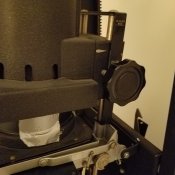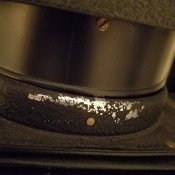From the photos you showed, your upper bellows was definitely incorrectly assembled where it joins the condenser unit. The tape shown and any residual adhesive must be removed, so that the bellows can freely slide over the outside diameter of the condenser housing.
The annular bulge formed onto the cylindrical body of the condenser unit serves the important purpose of retaining the bellows so that the bellows won’t slip off of the condenser housing on upward travel. It requires force to fit the bellows over the bulge as you assemble the bellows over the condenser housing. Once that’s accomplished the bulge retains the top of the bellows on the condenser housing during upward travel of the housing and lamp head.
You might make assembly a bit easier by waxing the bulge and the outside diameter of the condenser housing with auto-body wax and buffing it smooth. That should also allow the bellows to slip more freely over the housing when adjusting the lamp house and condenser unit height to accommodate format changes.
As the lamphouse and condenser are raised, the condenser unit rises and slips freely inside the circular hole in the bellows until the larger-diameter bulge encounters the bellows. The bulge cannot freely pass through the circular hole in the bellows due to the interference fit, so further upward movement of the condenser & lamphouse begins pulling the bellows upward expanding them.
On downward travel of the lamphouse and bellows as a unit, the bellows begin to collapse until they are nearly compressed. Further downward travel causes the smooth body of the condenser unit to begin to slide down inside the compressed bellows (clearance is provided) so that the condensers can be brought closer to the negative for even illumination of larger negatives up to 6 x 9 cm.
Older manual:
http://www.jollinger.com/photo/cam-coll/manuals/enlargers/beseler/Beseler_23C(older).pdf
Newer manual:
http://www.jollinger.com/photo/cam-coll/manuals/enlargers/beseler/Beseler_23C(newer).pdf
Focusing the Condenser Unit:
The format guide scale is a good starting point, but due to way that the parts fit together, some of these 23C enlargers with the condenser system produce uneven illumination at the height setting for the format in use. I experimented with mine and found a way to improve this on 23Cs that have such a problem.
I first focus a negative at the indicated format setting. Then I remove the negative and re-install the carrier. I project white light with onto a sheet of white paper with the lens aperture closed 1 stop (for evenness of the projected light insofar as the lens is a factor). Then I fine-tune the position of the lamphouse and bellows for the most uniform illumination on the white paper. This is the condenser height that I will use to print.
On some 23C enlargers the best height is close to the marked setting on the scale. On others, it might require a 10 mm or more difference in condenser height compared to the marked format height to obtain the most uniform light on the white paper.












 . All the pictures in the manuals show the Bellows floating. It's not like my 4x5 where they are smashed tight.
. All the pictures in the manuals show the Bellows floating. It's not like my 4x5 where they are smashed tight.